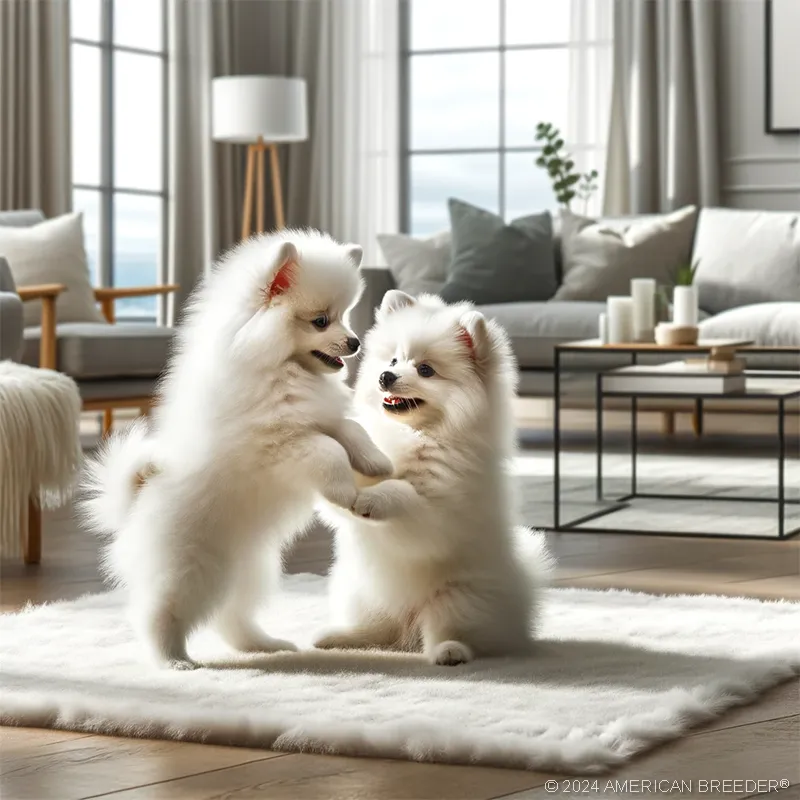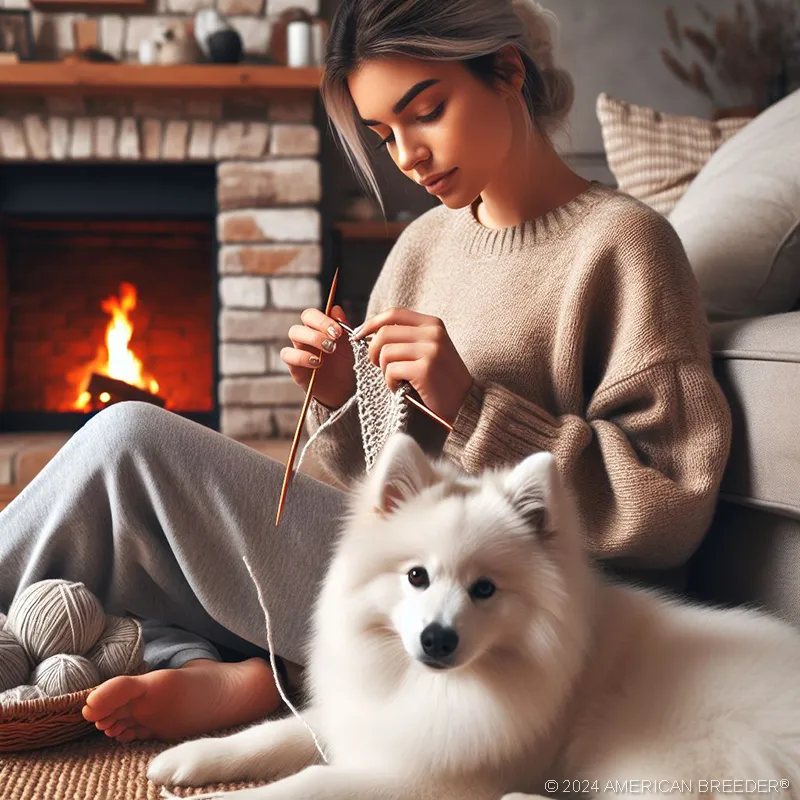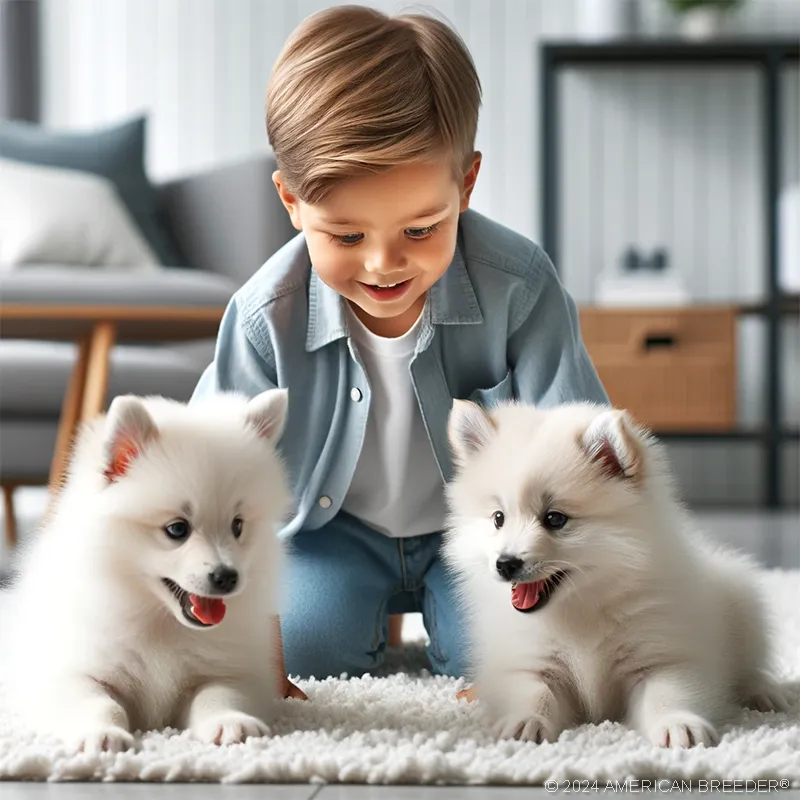Fluffy Magic: Discover the World of the American Eskimo Dog!
Introduction and Breed Background
 The American Eskimo Dog, often affectionately known as the "Eskie," is a captivating and lively breed that originated from the Arctic regions of Europe. Despite the name, this breed is proudly American, known for its beautiful white coat and intelligent eyes that exude curiosity and mischief. As a member of the Spitz family, the American Eskimo Dog boasts a fox-like face, a plumed tail that curls gracefully over its back, and a keen intelligence that sets it apart from other breeds.
The American Eskimo Dog, often affectionately known as the "Eskie," is a captivating and lively breed that originated from the Arctic regions of Europe. Despite the name, this breed is proudly American, known for its beautiful white coat and intelligent eyes that exude curiosity and mischief. As a member of the Spitz family, the American Eskimo Dog boasts a fox-like face, a plumed tail that curls gracefully over its back, and a keen intelligence that sets it apart from other breeds.
Before bringing an American Eskimo Dog into your life, there are essential considerations to keep in mind. Their playful and active nature makes them an excellent fit for families and individuals leading an active lifestyle and willing to dedicate ample time to their furry companion. Training and socialization are crucial for these intelligent dogs to thrive, so prospective owners should be prepared to invest time and effort in these areas.
Now, let's explore some fascinating facts about the American Eskimo Dog. While commonly known as the American Eskimo Dog, this breed has also been referred to as the "American Spitz" and the "White German Spitz," reflecting its heritage and distinctive appearance. Fondly nicknamed "Eskie" by its adoring owners, this breed's playful and affectionate nature has earned it various other endearing monikers, including "Fluffball," "Snowball," and "Cloud Dog."
Breed Background and History
The American Eskimo Dog's roots can be traced back to the late 19th and early 20th centuries when German immigrants brought their Spitz-type dogs to the United States. These dogs were crossbred with various European Spitz breeds, laying the foundation for the American Eskimo Dog we know today. Their exceptional intelligence and agility made them popular performers in circuses and traveling shows, garnering admiration and recognition throughout the country.
While the historical origins of the American Eskimo Dog are somewhat veiled in mystery, their ancestors were essential companions to the indigenous peoples of the Arctic. Bred for their adaptability and hunting skills, these dogs played a crucial role in herding, hunting, and providing warmth during the harsh winters.
 The American Eskimo Dog's original purpose was as an all-around farm dog, excelling in herding, guarding, and vermin control. Their versatility allowed them to adapt to various tasks and environments, making them invaluable to early settlers and farmers.
The American Eskimo Dog's original purpose was as an all-around farm dog, excelling in herding, guarding, and vermin control. Their versatility allowed them to adapt to various tasks and environments, making them invaluable to early settlers and farmers.
In the modern era, the American Eskimo Dog is classified under the Non-Sporting Group by kennel clubs, including the American Kennel Club (AKC) and the United Kennel Club (UKC). Their registration with these prestigious organizations solidifies their status as a beloved and recognized breed within the canine community.
Appearance
The American Eskimo Dog comes in three size varieties: Toy, Miniature, and Standard. The Toy variety stands at around 9-12 inches tall and weighs between 6 to 10 pounds, while the Miniature variety measures 12-15 inches in height and weighs approximately 10 to 20 pounds. The Standard variety is the largest, standing at 15-19 inches tall and weighing 25 to 35 pounds. Despite their size differences, all varieties share the same distinctive appearance, with a luxurious white double coat and erect, triangular ears.
One of the most striking features of the American Eskimo Dog is its beautiful white coat, composed of a thick, insulating undercoat and a longer, dense outer coat that creates a fluffy and elegant appearance. The coat comes in pure white, and while some may have biscuit cream markings on the ears, this is considered a fault according to breed standards.
The American Eskimo Dog's fox-like face and alert, almond-shaped eyes are among its most distinguishing features. Their eyes are dark and expressive, reflecting their intelligence and charm. The plumed tail that curls over their back adds to their elegance and allure.
On average, the American Eskimo Dog will have a litter size ranging from 3 to 5 puppies. Responsible breeding practices aim to ensure the health and well-being of both the dam and her offspring.
Temperament and Personality
 The American Eskimo Dog is renowned for its friendly and outgoing nature, making it an excellent family companion. They are affectionate and devoted to their human family members, always seeking attention and eager to participate in family activities. This breed thrives on companionship and is known for forming strong bonds with their owners.
The American Eskimo Dog is renowned for its friendly and outgoing nature, making it an excellent family companion. They are affectionate and devoted to their human family members, always seeking attention and eager to participate in family activities. This breed thrives on companionship and is known for forming strong bonds with their owners.
Due to their moderate to high energy levels, American Eskimo Dogs are always ready for playtime and physical activities. Regular exercise is essential to prevent boredom and ensure their mental and physical well-being. Engaging in activities that challenge their intelligence and agility, such as obedience training and agility courses, can be highly rewarding for both the dog and the owner.
The American Eskimo Dog's adaptability makes it suitable for various lifestyles, from active families to individuals living in apartments. However, they thrive best in homes where they receive ample attention, exercise, and mental stimulation. Families with children will find a playful and affectionate companion in the American Eskimo Dog, but early socialization and training are essential to ensure harmonious interactions.
Like any breed, the American Eskimo Dog may exhibit certain behavior issues if not properly trained and socialized. Potential challenges may include aggression, excessive barking, digging behavior, separation anxiety, and resource guarding. Early training, positive reinforcement, and consistent boundaries can help address and manage these issues effectively.
Trainability and Intelligence
The American Eskimo Dog is highly trainable, thanks to its intelligence and willingness to please its owner. This breed thrives on mental stimulation, making training sessions both enjoyable and rewarding. Positive reinforcement techniques, such as using treats and praise, work exceptionally well with this breed, fostering a strong bond between dog and owner.
 Their intelligence extends to problem-solving abilities, making them quick learners in various training scenarios. Engaging in obedience training and interactive games that challenge their minds will keep them mentally sharp and content.
Their intelligence extends to problem-solving abilities, making them quick learners in various training scenarios. Engaging in obedience training and interactive games that challenge their minds will keep them mentally sharp and content.
The American Eskimo Dog's intelligence also makes them ideal candidates for advanced training or specialized activities. From canine sports like agility and flyball to therapy work, this breed excels in various roles, showcasing its versatility and adaptability.
Practical Considerations
When welcoming an American Eskimo Dog into your home, several practical considerations should be taken into account. The size of their sleeping quarters will depend on the variety you choose, with the Toy variety requiring less space than the Standard variety.
It's essential to budget for their care, including typical annual veterinary costs, grooming needs, and daily exercise requirements. The American Eskimo Dog's grooming needs are moderate, with regular brushing, occasional bathing, nail trimming, and ear cleaning being part of their routine.
Feeding requirements will vary based on the dog's size, age, and activity level. Consulting with a veterinarian or canine nutritionist can help determine the appropriate portion sizes, feeding schedule, and recommended dog food brands.
Health and Care
While the American Eskimo Dog is generally a healthy breed, they may be prone to certain health issues, such as hip dysplasia, luxating patellas, and progressive retinal atrophy (PRA). Regular health check-ups with a veterinarian are essential to monitor their overall well-being and catch any potential health concerns early.
 Providing a balanced and nutritious diet, regular exercise, and mental stimulation are vital components of maintaining the American Eskimo Dog's overall health and well-being. Ensuring they receive proper nutrition helps support their immune system, joint health, and coat condition.
Providing a balanced and nutritious diet, regular exercise, and mental stimulation are vital components of maintaining the American Eskimo Dog's overall health and well-being. Ensuring they receive proper nutrition helps support their immune system, joint health, and coat condition.
Grooming requirements for the American Eskimo Dog are determined by their coat type and size. Regular brushing is necessary to prevent matting and keep their coat in top condition. Bathing should be done on an as-needed basis, and their nails should be trimmed regularly to avoid overgrowth and potential discomfort.
Exercise plays a crucial role in keeping the American Eskimo Dog physically and mentally stimulated. Daily walks, playtime, and interactive games are essential to burn off their energy and prevent behavioral issues that may arise from boredom.
To safeguard their health, a proper vaccination schedule is necessary to protect the American Eskimo Dog from common canine illnesses. Core vaccines, non-core vaccines, flea and tick prevention, and heartworm prevention are vital components of their preventive care.
Regular veterinary check-ups are crucial for monitoring their health and addressing any health concerns promptly. Being attentive to signs of potential health problems, such as changes in appetite, behavior, or energy levels, can help owners identify issues early and seek veterinary attention.
Socialization and Compatibility
The American Eskimo Dog is a sociable breed that generally gets along well with children, other pets, and strangers when properly socialized from a young age. Early socialization is crucial to ensure they grow up to be well-adjusted and confident dogs.
 Interactions with children should always be supervised, as with any dog breed, to prevent unintentional rough play or discomfort for either the dog or the child. Teaching children how to interact safely and respectfully with the dog helps foster a strong bond and a harmonious family environment.
Interactions with children should always be supervised, as with any dog breed, to prevent unintentional rough play or discomfort for either the dog or the child. Teaching children how to interact safely and respectfully with the dog helps foster a strong bond and a harmonious family environment.
When introducing an American Eskimo Dog to a household with other pets, gradual introductions and positive reinforcement can help facilitate a smooth integration. Early socialization with other animals can ensure they grow up to be friendly and well-mannered around other pets.
Living Arrangements and Environment
The American Eskimo Dog's adaptability makes it suitable for various living arrangements, including apartments, suburban homes, and rural settings. However, they thrive best in environments where they have access to a secure yard for play and exercise.
The breed can tolerate both cold and warm climates, thanks to its thick double coat that provides insulation from extreme weather conditions. Providing adequate shade and fresh water during hot days is essential to keep them comfortable.
Ideal living conditions for the American Eskimo Dog include a safe and comfortable sleeping area, regular exercise opportunities, and mental stimulation to keep their active minds engaged.
Training and Obedience
Basic obedience training is essential for the American Eskimo Dog to learn manners and respond to commands reliably. Training sessions should be consistent, positive, and reward-based, ensuring a positive learning experience for the dog.
 Advanced training or specialized activities, such as agility, rally, or therapy work, are well-suited for the American Eskimo Dog's intelligence and willingness to learn. Engaging in these activities can further strengthen the bond between dog and owner while providing mental and physical stimulation.
Advanced training or specialized activities, such as agility, rally, or therapy work, are well-suited for the American Eskimo Dog's intelligence and willingness to learn. Engaging in these activities can further strengthen the bond between dog and owner while providing mental and physical stimulation.
House training and potty training should begin early in the puppy's life to establish good habits and prevent accidents indoors. Consistency, positive reinforcement, and patience are key factors in successful house training.
Leash training is essential for walking etiquette and ensuring the dog's safety during outings. Teaching them to walk politely on a leash helps prevent pulling and ensures enjoyable walks for both the dog and the owner.
Exercise and Activity
The American Eskimo Dog is a breed with moderate to high exercise needs, making regular physical activity a necessity. Daily walks, playtime, and engaging in interactive games help them burn off energy and prevent behavioral issues stemming from boredom.
Mental stimulation is equally important for the American Eskimo Dog. Engaging in training sessions, puzzle toys, and interactive games challenges their intelligence and keeps their minds sharp and engaged.
Energy outlets for high-energy breeds like the American Eskimo Dog include activities such as agility training, flyball, or canine sports, which allow them to showcase their athleticism and intelligence while building a strong bond with their owner.
Financial Planning
 When considering adopting or purchasing an American Eskimo Dog, it's essential to factor in the associated costs. These costs may include adoption fees or purchase price, vaccinations, spaying/neutering, microchipping, food, grooming, veterinary care, training, toys, and supplies.
When considering adopting or purchasing an American Eskimo Dog, it's essential to factor in the associated costs. These costs may include adoption fees or purchase price, vaccinations, spaying/neutering, microchipping, food, grooming, veterinary care, training, toys, and supplies.
Setting aside a budget for unexpected medical costs, such as accidents or illnesses, is prudent. Pet insurance can offer peace of mind and financial security, covering potential medical expenses during emergencies.
For families or individuals planning vacations or travel, arrangements for pet care should be made. Options include pet sitters, boarding facilities, or relying on trusted family or friends to care for the dog during their absence.
Overall Summary
In summary, the American Eskimo Dog is a delightful and intelligent breed with a captivating white coat and fox-like appearance. Their friendly and outgoing nature makes them excellent family companions, while their intelligence and trainability make them ideal candidates for various activities and training endeavors.
Responsible ownership involves providing proper care, training, and socialization, as well as adhering to legal regulations. Commitment, patience, and love are essential elements for nurturing a strong bond with your American Eskimo Dog and ensuring their well-being and happiness.
Throughout this comprehensive guide, we have explored the American Eskimo Dog's background and history, delving into their Arctic origins and their journey to becoming a beloved and recognized breed in the United States. We have admired their striking appearance, with their plush white coat and distinctive fox-like features, making them stand out in any crowd.
 Understanding their temperament and personality has given us valuable insights into their playful and affectionate nature, as well as the importance of early training and socialization to foster well-adjusted and confident dogs. We have also addressed potential behavioral challenges and the role of positive reinforcement in training these intelligent and eager-to-please canines.
Understanding their temperament and personality has given us valuable insights into their playful and affectionate nature, as well as the importance of early training and socialization to foster well-adjusted and confident dogs. We have also addressed potential behavioral challenges and the role of positive reinforcement in training these intelligent and eager-to-please canines.
Practical considerations, such as grooming, exercise, and proper nutrition, are essential elements in maintaining the American Eskimo Dog's health and well-being. Regular veterinary care and preventive measures, including vaccinations and flea and tick prevention, contribute to a long and healthy life for our furry companions.
We have discussed the importance of responsible ownership, whether through adoption from shelters or choosing reputable breeders who prioritize the breed's health and welfare. Avoiding puppy mills and understanding the significance of spaying and neutering are integral components of promoting ethical breeding practices.
As we conclude this guide, it is essential to emphasize the commitment required to care for an American Eskimo Dog. Providing a loving and suitable home, meeting their physical and emotional needs, and fostering a strong bond with these intelligent and affectionate dogs will reward owners with a loyal and devoted companion for years to come.
Remember that owning an American Eskimo Dog is a journey filled with joy, love, and unforgettable moments. Each dog is unique, bringing its own quirks and charms into our lives. Embrace the adventure, seek expert guidance when needed, and cherish the incredible bond you will form with your American Eskimo Dog.
With the knowledge and insights shared in this comprehensive guide, you are now equipped to embark on this wonderful journey with your American Eskimo Dog. Enjoy the laughter, the playful antics, and the warmth they bring to your heart and home. May your days be filled with love, companionship, and endless tail wags as you create beautiful memories with your American Eskimo Dog. Happy pet ownership!
American Eskimo Dog Quick Reference Guide
Breed Background: Origin: Germany | Breed Purpose: Companion Dog | AKC Class: Non-Sporting | Year Recognized by AKC: 1995
 Appearance: Size: Toy, Miniature, Standard | Weight: Toy: 6-10 lbs, Miniature: 10-20 lbs, Standard: 25-35 lbs | Coat Type: Double Coat, Dense and Fluffy | Colors & Patterns: White or Cream | Distinctive Features: Profuse Mane, Plumed Tail, Alert Expression
Appearance: Size: Toy, Miniature, Standard | Weight: Toy: 6-10 lbs, Miniature: 10-20 lbs, Standard: 25-35 lbs | Coat Type: Double Coat, Dense and Fluffy | Colors & Patterns: White or Cream | Distinctive Features: Profuse Mane, Plumed Tail, Alert Expression
Temperament: Energy Level: 3 | Friendliness to Pets: 4 | Friendliness to Strangers: 3 | Trainability: 4 | Playfulness: 5 | Frequent Barker: 3 | Chase Instincts: 2 | Sense of Smell: 3 | Drive to Hunt: 2
Health & Care: Health Issues: Hip Dysplasia, Progressive Retinal Atrophy | Lifespan: 12-15 years | Grooming Difficulty: Moderate | Exercise Needs: Moderate
Socialization: Interaction with Children: Good, Playful | Interaction with Pets: Generally Good, Can Be Dominant | Interaction with Strangers: Cautious but Friendly | Ease of Training: Highly Trainable
Suitable Living Arrangements: Apartment: Yes | House: Yes | Rural Area: Yes | Yard Size Requirements: Small Yard Sufficient
Training & Obedience: Trainability: 4 | Intelligence: 4 | Obedience: 4 | Problem-Solving: 3 | Easily Stimulated: 3 | Focus Level: 4 | Easily Distracted: 3
Financial Planning: Typical Price Range: $800 - $3,000 | Initial Expenses: Moderate (Vaccinations, Supplies) | Ongoing Annual Expenses: Moderate (Food, Vet Visits)
Breeding: Reproductive Maturity: 6-12 months | Litter Frequency: 1-2 per year | Litter Size: 3-5 puppies | Stud Cost: $500 - $1,500 | Breeding Challenges: Careful Pairing Needed to Avoid Health Issues
Did You Enjoy this Article? Share it and Help Us Spread the Word!
If you found this article helpful, we'd appreciate it if you could share it with your friends or link to it from your website, blog, or group! You can also use the convenient social share tabs on the left side of the screen to instantly share this page to your social media feed. For more ways to support and promote the American Breeder Community, visit our Share & Promote Together page for social media posts and memes you can copy and share. Your support means the world to us!
Disclaimer: The information provided in this article is for general informational purposes only and does not constitute legal, medical, financial, or professional advice. While we strive for accuracy, we make no representations or warranties regarding the completeness, accuracy, reliability, or suitability of the information. Please consult with a professional before making decisions based on the content provided. American Breeder Inc. assumes no responsibility for any errors or omissions or for the results obtained from the use of this information.
